Short-Term Geomorphological Changes of the Sabato River (Southern Italy)
Abstract
1. Introduction
2. Materials and Methods
2.1. Study Area
2.2. Data Source and Methodology
3. Results
3.1. Geomorphological Analysis of the Sabato R. Channel
3.1.1. Confinement
3.1.2. Changes in Mean Active Channel Width
3.1.3. Channel Pattern
3.1.4. Riverbed Elevation Changes
3.2. Controlling Factors
3.2.1. Land-Use Changes at the Basin Scale
3.2.2. Other Human Disturbances
3.3. Hydrological Data
4. Discussion
4.1. Phase 1 (~1870–1909)
4.2. Phase 2 (~1909–1941)
4.3. Phase 3 (~1941–1998)
4.3.1. Sub-Phase 3A (~1941–1955)
4.3.2. Sub-Phase 3B (~1955–1998)
4.4. Phase 4 (~1998–2014)
5. Conclusions
Author Contributions
Funding
Data Availability Statement
Conflicts of Interest
Correction Statement
References
- Winterbottom, S.J. Medium and short-term channel planform changes on the Rivers Tay and Tummel, Scotland. Geomorphology 2000, 34, 195–208. [Google Scholar] [CrossRef]
- Liébault, F.; Piégay, H. Causes of twentieth century channel narrowing in mountain and Piedmont rivers of southeastern France. Earth Surf. Process. Landf. 2002, 27, 425–444. [Google Scholar] [CrossRef]
- Hooke, J.M. Human impacts on fluvial systems in the Mediterranean region. Geomorphology 2006, 79, 311–335. [Google Scholar] [CrossRef]
- Yao, Z.; Xiao, J.; Jia, X. Planform channel dynamics along the Ningxia-Inner Mongolia reaches of the Yellow river from 1958 to 2008: Analysis using Landsat images and topographic maps. Environ. Earth Sci. 2012, 70, 97–106. [Google Scholar] [CrossRef]
- Heitmuller, F.T. Channel adjustments to historical disturbances along the lower Brazos and Sabine River, south-central USA. Geomorphology 2014, 204, 382–398. [Google Scholar] [CrossRef]
- Rădoane, M.; Obreja, F.; Cristea, I.; Mihailă, D. Changes in the channel-bed level of the eastern Carpathian rivers: Climatic vs. human control over the last 50 years. Geomorphology 2013, 193, 91–111. [Google Scholar] [CrossRef]
- Surian, N.; Rinaldi, M. Morphological response to river engineering and management in alluvial channels in Italy. Geomorphology 2003, 50, 307–326. [Google Scholar] [CrossRef]
- Surian, N.; Rinaldi, M.; Pellegrini, L.; Audisio, C.; Maraga, F.; Teruggi, L.; Turitto, O.; Ziliani, L. Channel adjustments in northern and central Italy over the last 200 years. In Management and Restoration of the Fluvial Systems with Broad Historical Changes and Human Impacts; James, L.A., Rathburn, S.L., Whittecar, G.R., Eds.; Geological Society of America: Boulder, CO, USA, 2009; Special Paper 451; pp. 83–95. [Google Scholar] [CrossRef]
- Marchese, E.; Scorpio, V.; Fuller, I.; McColl, S.; Comiti, F. Morphological changes in Alpine rivers following the end of the Little Ice Age. Geomorphology 2017, 295, 811–826. [Google Scholar] [CrossRef]
- Magliulo, P.; Valente, A.; Cartojan, E. Recent morphological changes of the middle and lower Calore river (Campania, Southern Italy). Environ. Earth Sci. 2013, 70, 2785–2805. [Google Scholar] [CrossRef]
- Scorpio, V.; Aucelli, P.P.C.; Giano, I.; Pisano, L.; Robustelli, G.; Rosskopf, C.M.; Schiattarella, M. River channel adjustment in Southern Italy over the past 150 years and implications for channel recovery. Geomorphology 2015, 251, 77–90. [Google Scholar] [CrossRef]
- Magliulo, P.; Cusano, A. Geomorphology of the lower Calore River Alluvial Plain (Southern Italy). J. Maps 2016, 5, 1119–1127. [Google Scholar] [CrossRef]
- Magliulo, P.; Bozzi, F.; Pignone, M. Assessing the planform changes of the Tammaro River (southern Italy) from 1870 to 1955 using a GIS-aided historical map analysis. Environ. Earth Sci. 2016, 75, 355. [Google Scholar] [CrossRef]
- Scorpio, V.; Rosskopf, C.M. Channel adjustments in a Mediterranean river over the last 150 years in the context of anthropic and natural controls. Geomorphology 2016, 275, 90–104. [Google Scholar] [CrossRef]
- de Musso, N.M.; Capolongo, D.; Caldara, M.; Surian, N.; Pennetta, L. Channel changes and controlling factors over the past 150 years in the Basento River (Southern Italy). Water 2020, 12, 307. [Google Scholar] [CrossRef]
- Knox, J.C. Large increases in flood magnitude in response to modest changes in climate. Nature 1993, 361, 430–432. [Google Scholar] [CrossRef]
- Kiss, T.; Blanka, V. River channel response to climate- and human-induced hydrological changes: Case study on the meandering Hernád River, Hungary. Geomorphology 2012, 175–176, 115–125. [Google Scholar] [CrossRef]
- Lespinas, F.; Ludwig, W.; Heussner, S. Hydrological and climatic uncertainties associated with modeling the impact of climate change on water resources of small Mediterranean coastal rivers. J. Hydrol. 2014, 511, 403–422. [Google Scholar] [CrossRef]
- Cienciala, P.; Pasternack, G.B. Floodplain inundation response to climate, valley form, and flow regulation on a gravel-bed river in a Mediterranean-climate region. Geomorphology 2017, 282, 1–17. [Google Scholar] [CrossRef]
- Nardi, L.; Rinaldi, M. Spatio-temporal patterns of channel changes in response to a major flood event: The case of the Magra River (central–northern Italy). Earth Surf. Process. Land. 2015, 40, 326–339. [Google Scholar] [CrossRef]
- Righini, M.; Surian, N.; Wohl, E.; Marchi, L.; Comiti, F.; Amponsah, W.; Borga, M. Geomorphic response to an extreme flood in two Mediterranean rivers (northeastern Sardinia, Italy): Analysis of controlling factors. Geomorphology 2017, 290, 184–199. [Google Scholar] [CrossRef]
- Surian, N.; Righini, M.; Lucía, A.; Nardi, L.; Amponsah, W.; Benvenuti, M.; Borga, M.; Cavalli, M.; Comiti, F.; Marchi, L.; et al. Channel response to extreme floods: Insights on controlling factors from six mountain rivers in northern Apennines Italy. Geomorphology 2016, 272, 78–91. [Google Scholar] [CrossRef]
- Magliulo, P.; Valente, A. GIS-based geomorphological map of the Calore River flood plain near Benevento (Southern Italy) overflooded by the 15th October 2015 event. Water 2020, 12, 148. [Google Scholar] [CrossRef]
- Kondolf, G.M. Geomorphic and environmental effects of instream gravel mining. Landsc. Urban Plan. 1994, 28, 225–243. [Google Scholar] [CrossRef]
- Calle, M.; Alho, P.; Benito, G. Channel dynamics and geomorphic resilience in an ephemeral Mediterranean river affected by gravel mining. Geomorphology 2017, 285, 333–346. [Google Scholar] [CrossRef]
- Brookes, A.; Gregory, K.J. An assessment of river channelization in England and Wales. Sci. Total Environ. 1983, 27, 97–111. [Google Scholar] [CrossRef]
- Fortugno, D.; Boix-Fayos, C.; Bombino, G.; Denisi, P.; Quiñonero Rubio, J.M.; Tamburino, V.; Zema, D.A. Adjustments in channel morphology due to land-use changes and check dam installation in mountain torrents of Calabria (southern Italy). Earth Surf. Process. Landf. 2017, 42, 2469–2483. [Google Scholar] [CrossRef]
- Boix-Fayos, C.; Barbera, G.G.; Lopez-Bermudez, F.; Castillo, V.M. Effects of check dams, reforestation and land-use changes on river channel morphology: Case study of the Rogativa catchment (Murcia Spain). Geomorphology 2007, 91, 103–123. [Google Scholar] [CrossRef]
- Scorpio, V.; Piégay, H. Is afforestation a driver of change in Italian rivers within the Anthropocene era? Catena 2021, 198, 105031. [Google Scholar] [CrossRef]
- Magliulo, P.; Bozzi, F.; Leone, G.; Fiorillo, F.; Leone, N.; Russo, F.; Valente, A. Channel Adjustments over 140 years in response to extreme floods and land use change, Tammaro River, southern Italy. Geomorphology 2021, 383, 18. [Google Scholar] [CrossRef]
- Rinaldi, M.; Wyżga, B.; Surian, N. Sediment mining in alluvial channels: Physical effects and management perspectives. River Res. Appl. 2005, 21, 805–828. [Google Scholar] [CrossRef]
- Brierley, G.J.; Fryirs, K.A. Geomorphology and River Management. Applications of the River Styles Framework; Blackwell: Oxford, UK, 2005; 398p. [Google Scholar]
- Brierley, G.J.; Fryirs, K.A.; Boulton, A.; Cullum, C. Working with change: The importance of evolutionary perspectives in framing the trajectory of river adjustment. In River Futures. An Integrative Scientific Approach to River Repair; Brierley, G.J., Fryirs, K.A., Eds.; Island Press: Washington, DC, USA, 2008; pp. 65–84. [Google Scholar]
- Dufour, S.; Piegay, H. From the myth of a lost paradise to targeted river restoration: Forget natural references and focus on human benefits. River Res. Appl. 2009, 24, 568–581. [Google Scholar] [CrossRef]
- Rinaldi, M.; Surian, N.; Comiti, F.; Bussettini, M. A method for the assessment and analysis of the hydromorphological condition of Italian streams: The Morphological Quality Index (MQI). Geomorphology 2013, 180–181, 96–108. [Google Scholar] [CrossRef]
- Rinaldi, M.; Teruggi, L.B.; Simoncini, C.; Nardi, L. Dinamica recente ed attuale di alvei fluviali: Alcuni casi studio appenninici (Italia centro–settentrionale). Alp. Mediterr. Quat. 2008, 21, 291–308. [Google Scholar]
- Magliulo, P. Quaternary deposits and geomorphological evolution of the Telesina Valley (Southern Apennines). Geogr. Fis. Dinam. Quat. 2005, 28, 125–146. [Google Scholar]
- Bonardi, G.; D’Argenio, B.; Perrone, V. Geological map of Southern Apennines. Mem. Soc. Geol. It. 1988, 41. [Google Scholar]
- Slama, C.C.; Henriksen, S.W.; Theurer, C. Manual of Photogrammetry, 4th ed.; American Society of Photogrammetry: Falls Church, VI, USA, 1980; p. 1056. [Google Scholar]
- Taylor, J.R. An Introduction to Error Analysis; University Science Books: Sausalito, CA, USA, 1982; 327p. [Google Scholar]
- Rinaldi, M.; Surian, N.; Comiti, F.; Bussettini, M. A methodological framework for hydromorphological assessment, analysis and monitoring (IDRAIM) aimed at promoting integrated river management. Geomorphology 2015, 251, 122–136. [Google Scholar] [CrossRef]
- Surian, N.; Ziliani, L.; Cibien, L.; Cisotto, A.; Baruffi, F. Variazioni morfologiche degli alvei dei principali corsi d’acqua veneto-friuliani negli ultimi 200 anni. Alp. Mediterr. Quat. 2008, 21, 233–340. [Google Scholar]
- Schumm, S.A. A Tentative Classification of Fluvial River Channels; US Geological Survey Circular; United States Department of the Interior: Washington, DC, USA, 1963; p. 477. [Google Scholar]
- Rinaldi, M. Recent channel adjustments in alluvial rivers of Tuscany, Central Italy. Earth Surf. Process. Landf. 2003, 6, 507–608. [Google Scholar] [CrossRef]
- Ministero LL.PP. Annali Idrologici. Servizio Idrografico e Mareografico di Napoli, 1921–1999. Available online: https://centrofunzionale.regione.campania.it/#/pages/documenti/annali (accessed on 25 May 2005).
- Centro Funzionale Multirischi della Protezione Civile, Regione Campania. Available online: https://centrofunzionale.regione.campania.it/ (accessed on 25 May 2005).
- National Research Council (CNR)—Direzione Generale del Catasto. Carta Dell’utilizzazione del Suolo in Italia Alla Scala 1:200,000; Touring Club: Milan, Italy, 1960. [Google Scholar]
- Copernicus—Land Monitoring Service. Available online: https://land.copernicus.eu/pan-european/corine-land-cover/clc-1990 (accessed on 25 May 2025).
- Copernicus—Land Monitoring Service. Available online: https://land.copernicus.eu/pan-european/corine-land-cover/clc2012 (accessed on 25 May 2025).
- Magliulo, P.; Cusano, A.; Sessa, S.; Beatrice, M.; Russo, F. Multidecadal land-use changes and implications on soil protection in the Calore River Basin landscape (Southern Italy). Geosciences 2022, 12, 156. [Google Scholar] [CrossRef]
- IGMI. Available online: https://www.igmi.org/it/geoprodotti/foto-aeree/1954 (accessed on 25 May 2025).
- Geoportale Nazionale. Available online: http://www.pcn.minambiente.it/viewer/ (accessed on 25 May 2025).
- Diodato, N.; Santoni, G.; Cevasco, A.; Fiorillo, F.; Bellocchi, G. Damaging hydrological events during the exiting of the Little Ice Age in the highland area of Southern Italy. Int. J. Hydrol. Sci. Technol. 2021, 11, 136–165. [Google Scholar] [CrossRef]
- Brunetti, M.; Maugeri, M.; Monti, F.; Nanni, T. Changes in daily precipitation frequency and distribution in Italy over the last 120 years. J. Geophys. Res. Atmospheres 2004, 109, D05102. [Google Scholar] [CrossRef]
- Diodato, N. Climatic fluctuations in southern Italy since the 17th century: Reconstruction with precipitation records at Benevento. Climatic Change 2007, 80, 411–431. [Google Scholar] [CrossRef]
- Cresta, A. Le trasformazioni urbano-rurali del territorio beneventano attraverso le fonti cartografiche. In Agricoltura e Territorio. Alle Radici dello Sviluppo Agricolo nel Sannio; Ferrandino, V., Ed.; Franco Angeli Publisher: Milan, Italy, 2010; pp. 93–120. [Google Scholar]
- Keller, E.A. Introduction to Environmental Geology, 5th ed.; Prentice Hall: New York, NY, USA, 2012; 705p. [Google Scholar]
- Schumm, S.A. River Adjustment to Altered Hydrologic Regimen, Murrumbidgee River and Paleochannels, Australia; U.S. Government Printing Office: Washington, DC, USA, 1968; 65p. [Google Scholar]
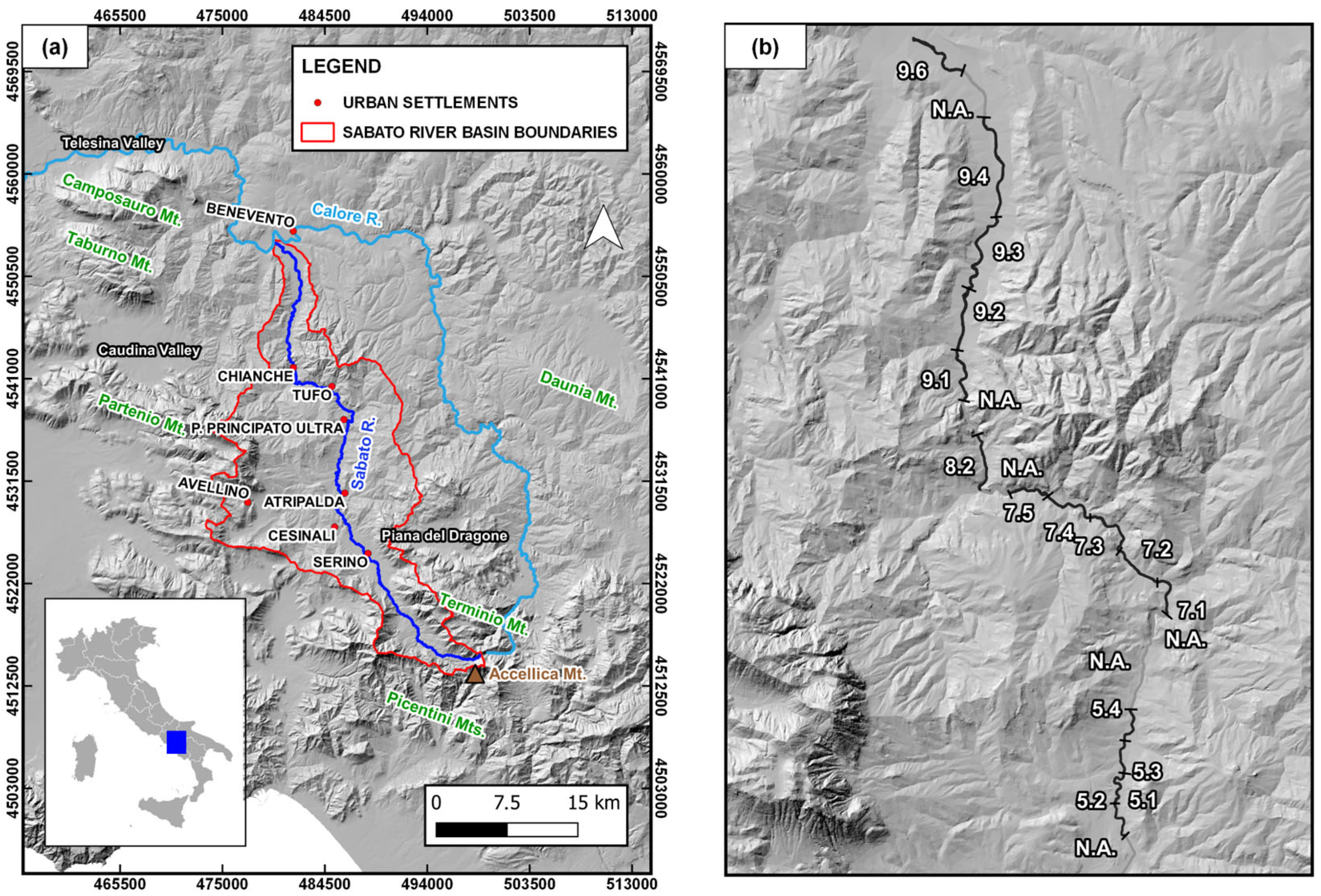
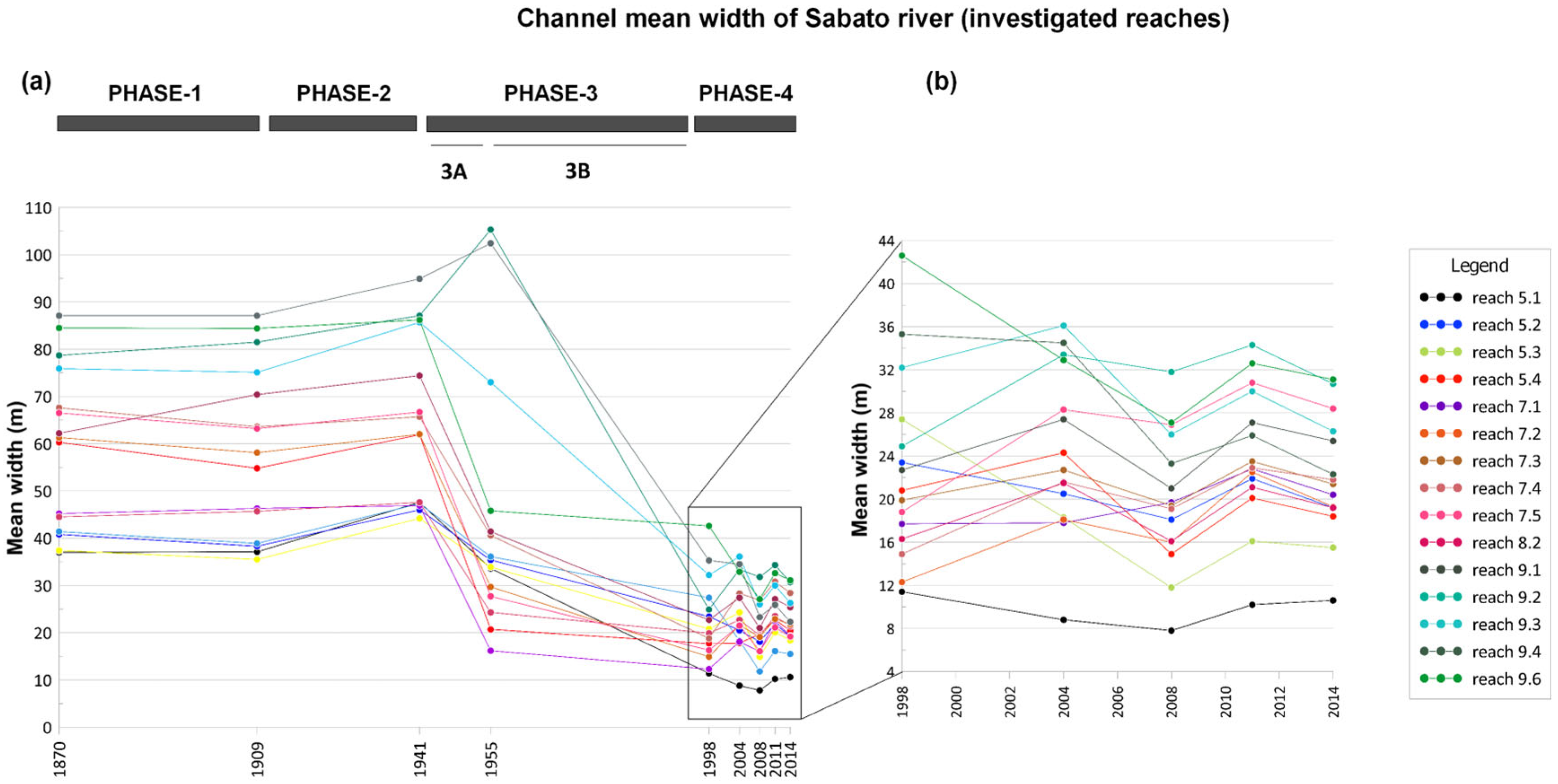
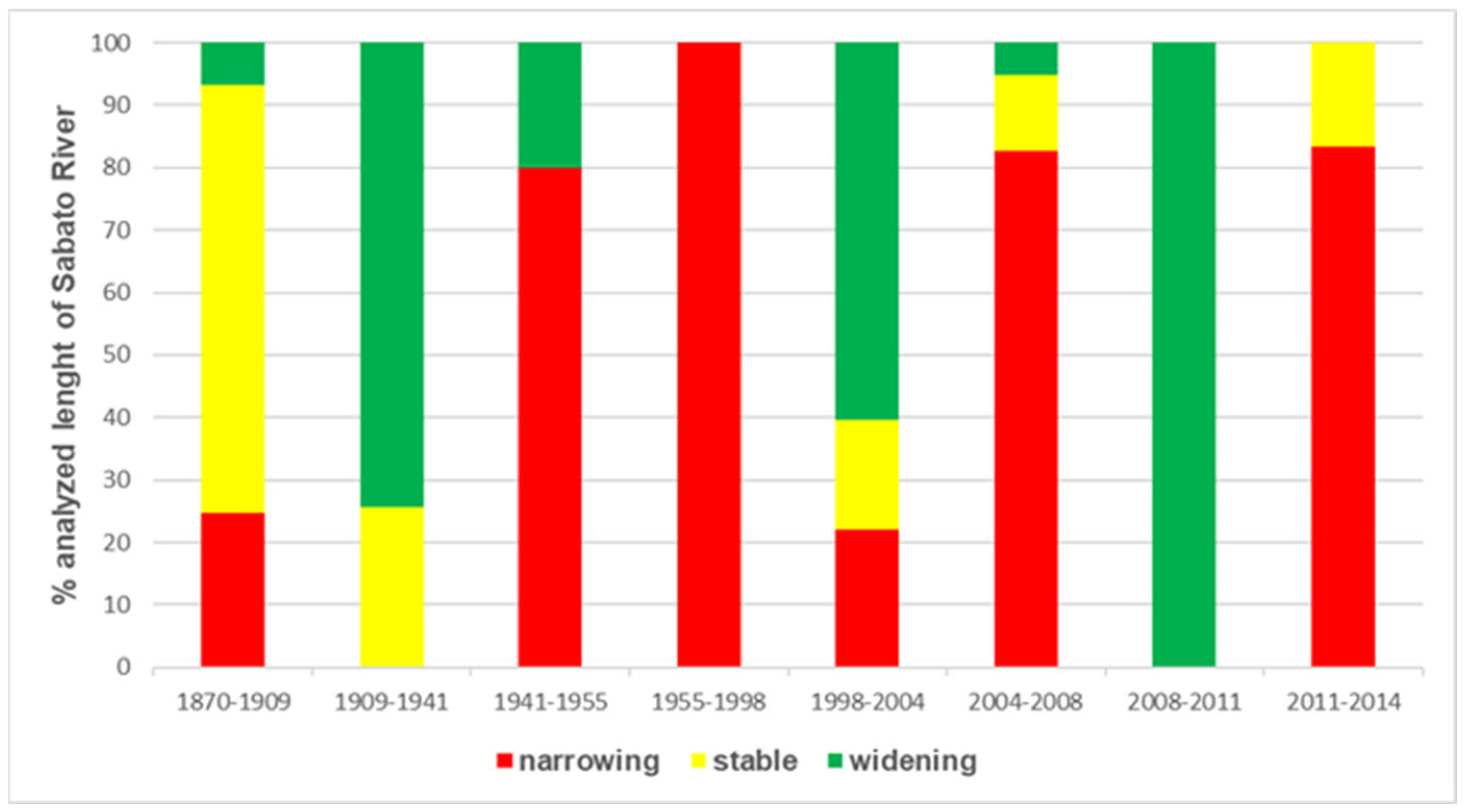
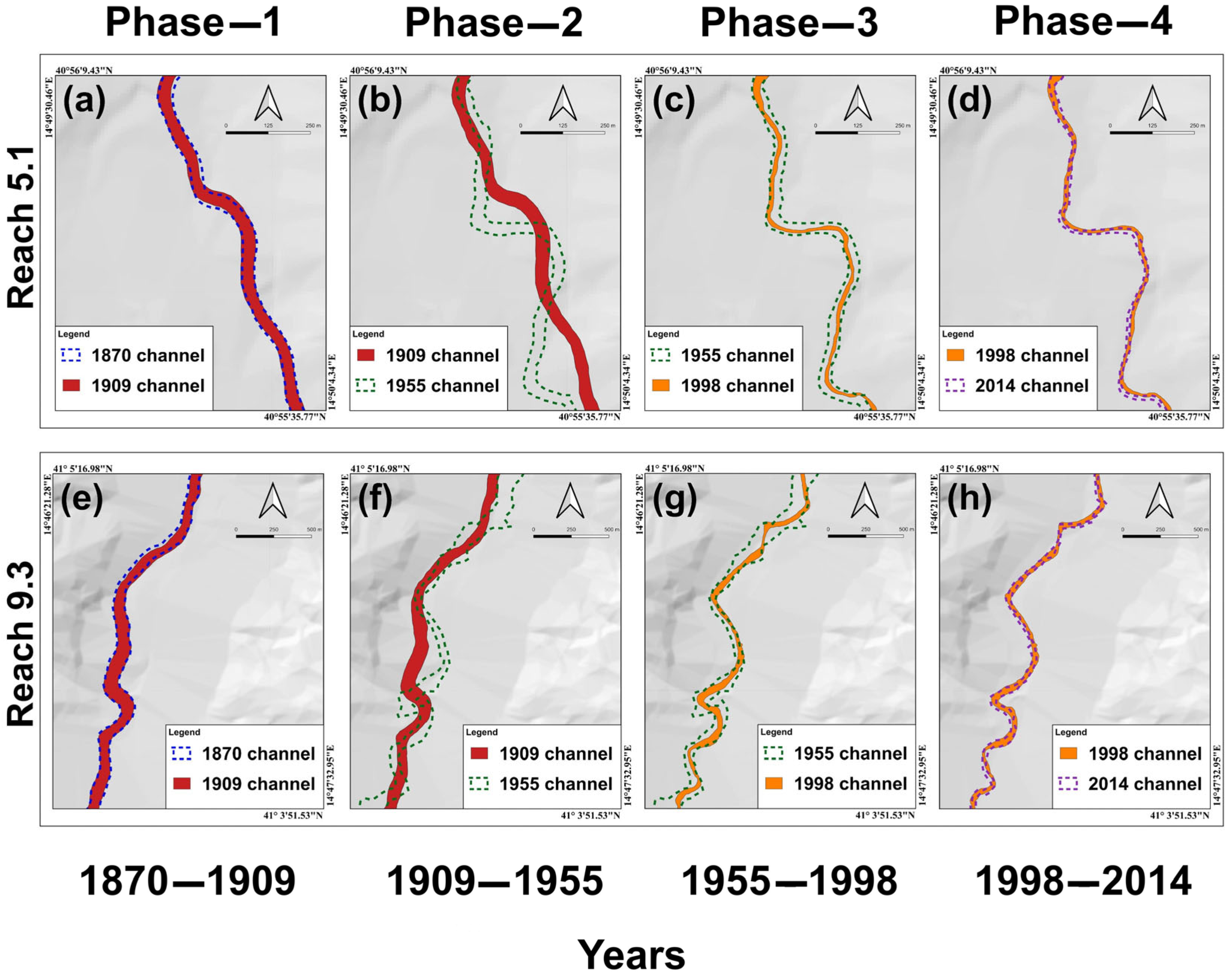
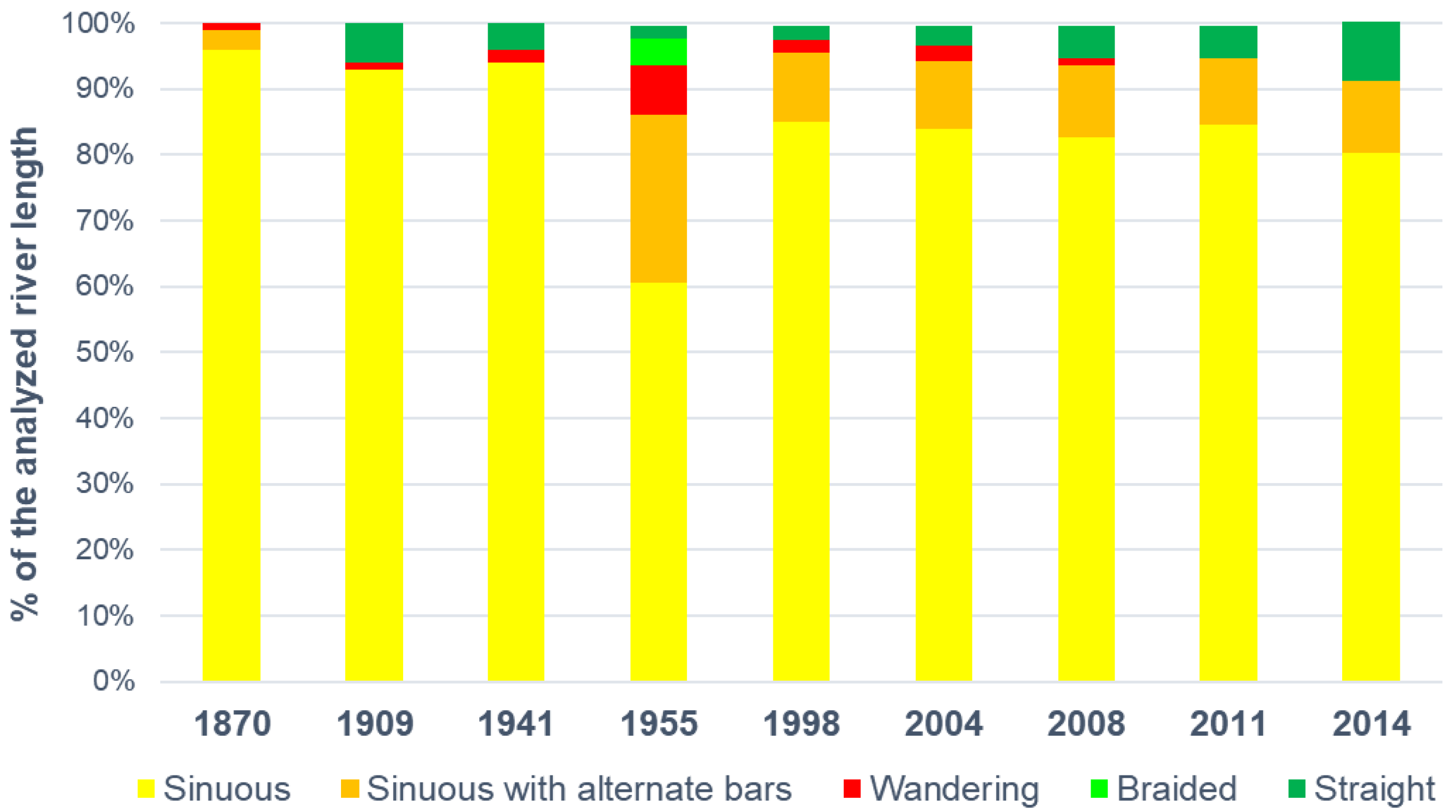
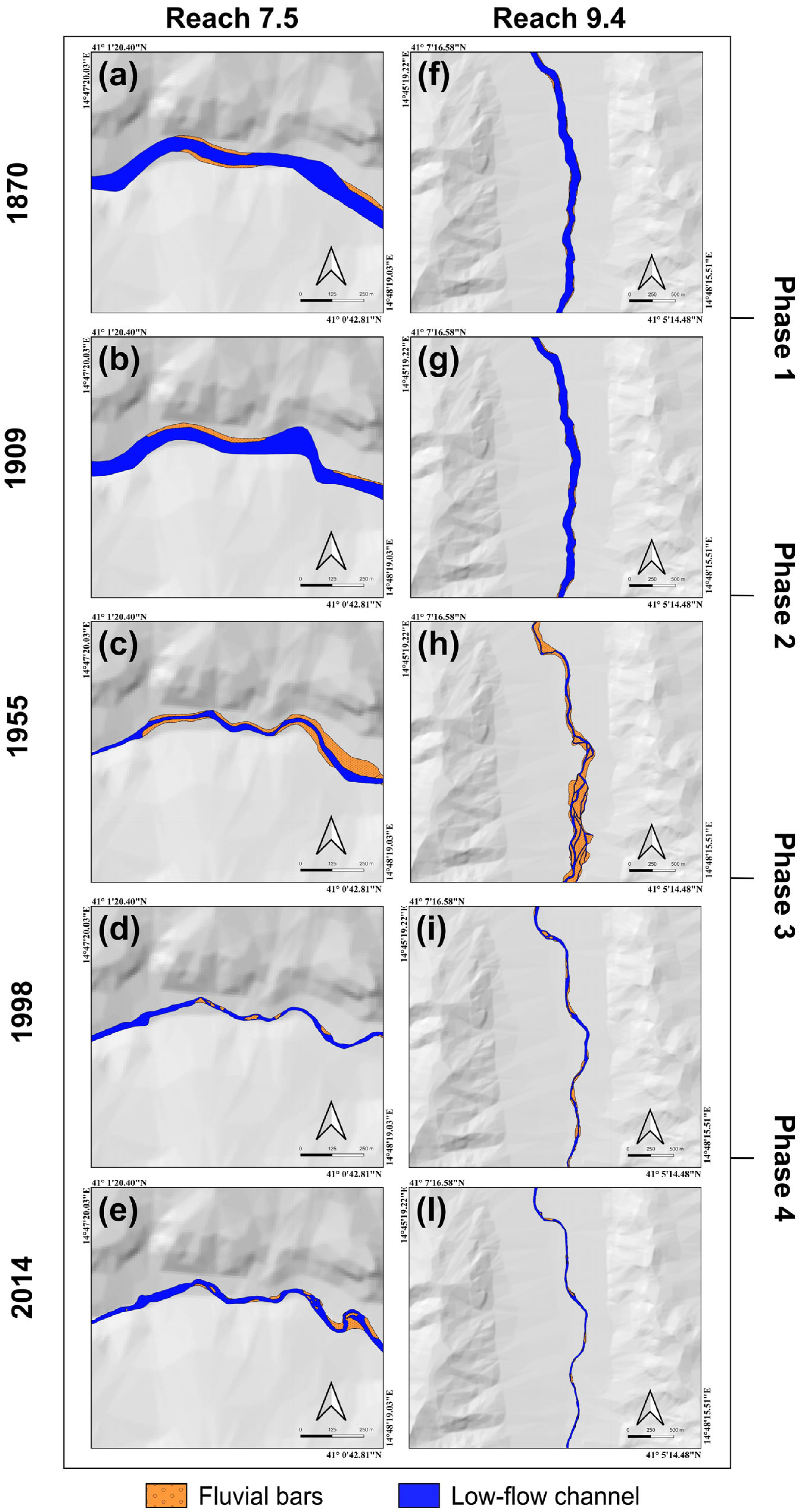

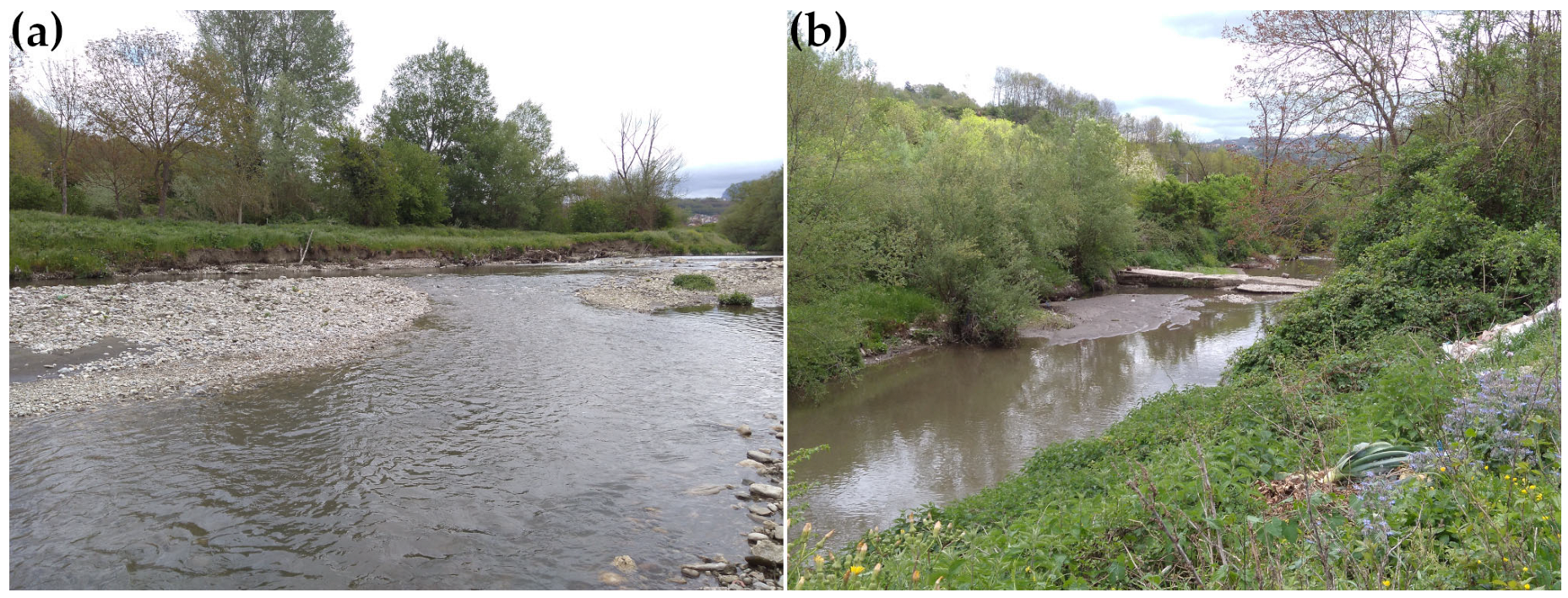
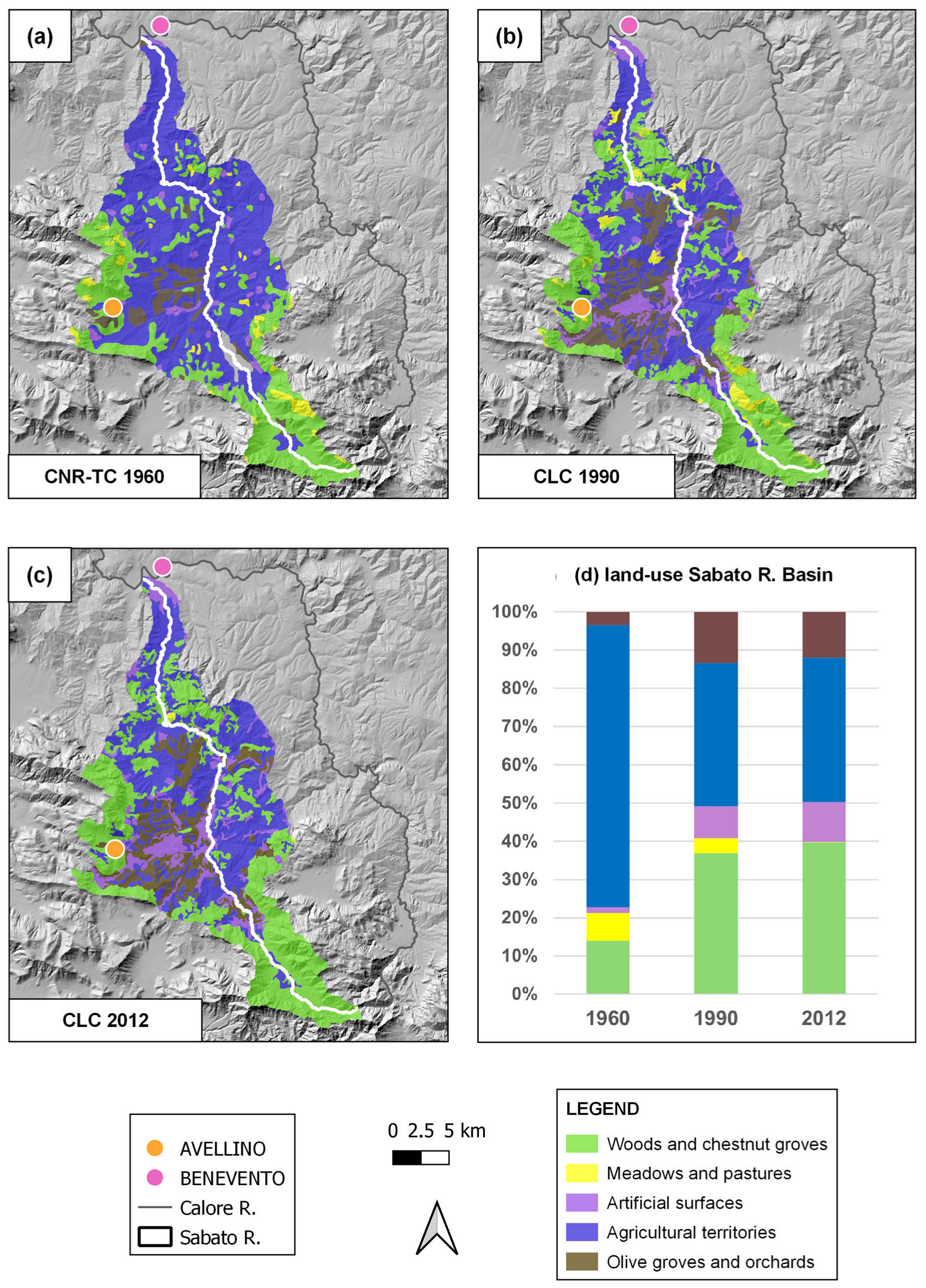
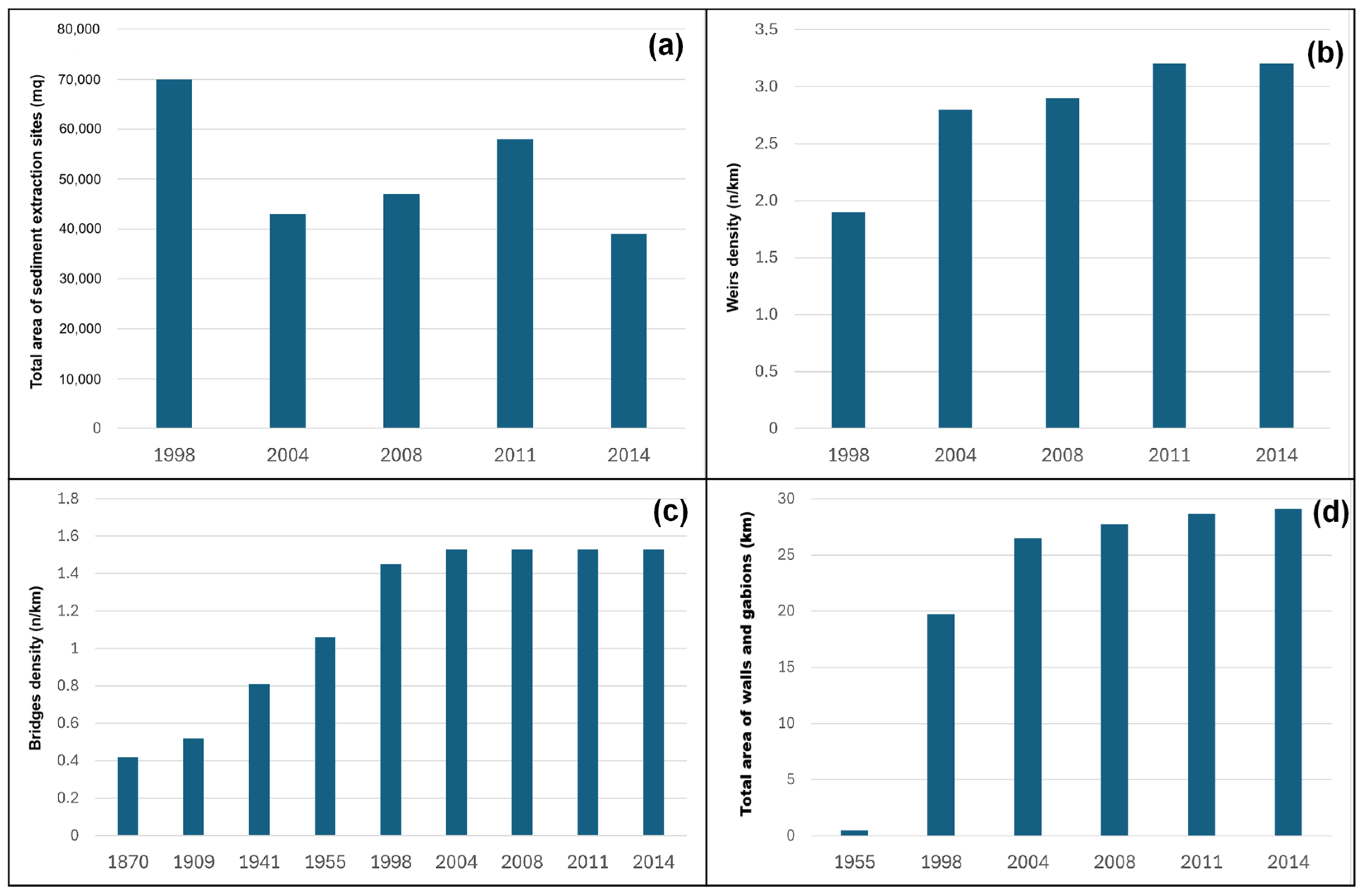
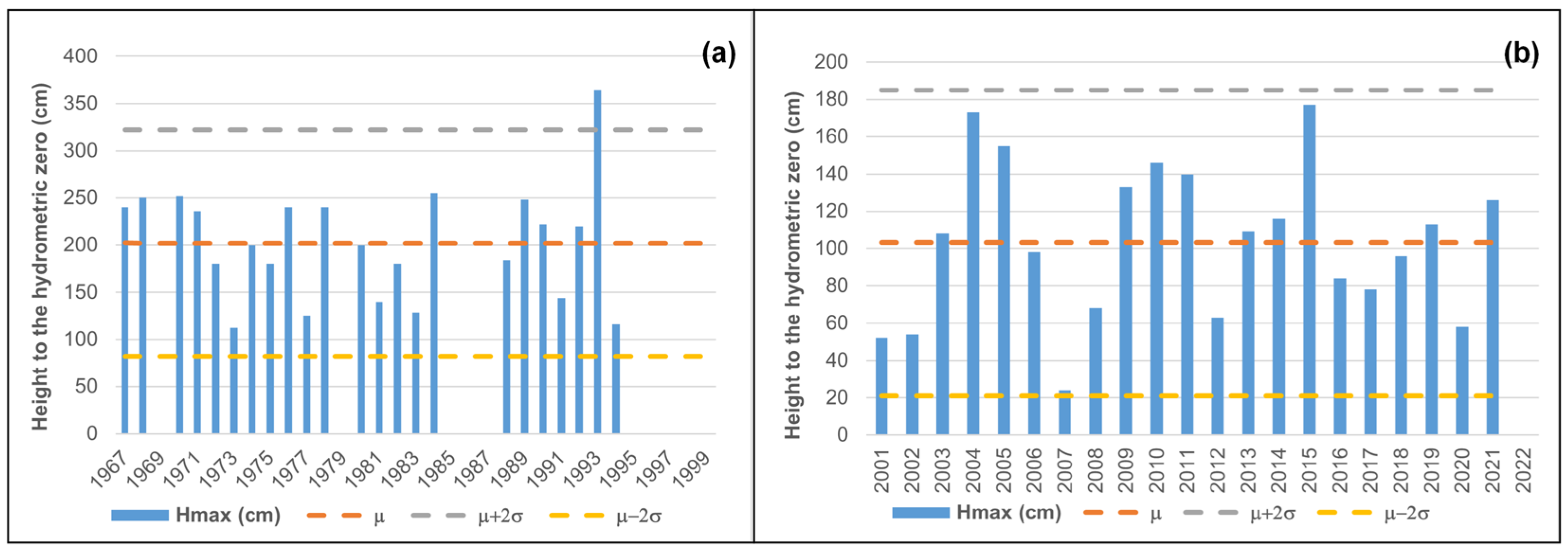

| Data Format | Year | Type | Provider | Scale | Pixel Size (m) | Positional Error (m) |
|---|---|---|---|---|---|---|
| R | 1870 | HM | IGMI | 1:50,000 | 5.4 | 33 |
| R | 1909 | HM | IGMI | 1:50,000 | 4.2 | 30 |
| R | 1941 | HM | IGMI | 1:50,000 | 4.0 | 29 |
| R | 1955 | TM | IGMI | 1:25,000 | 2.3 | 15 |
| R | 1998 | O | CRA | 1:13,000 | 2.0 | 2 |
| R | 2004 | O | CRA | 1:5000 | 0.2 | - |
| R | 2008 | O | CRA | 1:5000 | 0.5 | - |
| R | 2011 | O | CRA | 1:5000 | 0.2 | - |
| R | 2014 | O | CRA | 1:5000 | 0.2 | - |
| Reach | Length (m) | CD (%) | CI | CC |
|---|---|---|---|---|
| 5.1 | 1255 | 8.5 | 23.9 | Unconfined |
| 5.2 | 1391 | 15.0 | 8.1 | Partly confined |
| 5.3 | 1040 | - | 26.0 | Unconfined |
| 5.4 | 1106 | 49.9 | 13.1 | Partly confined |
| 7.1 | 1314 | - | 20.2 | Unconfined |
| 7.2 | 1489 | 4.1 | 15.5 | Unconfined |
| 7.3 | 1817 | 50.0 | 6.0 | Partly confined |
| 7.4 | 1665 | 27.7 | 9.8 | Partly confined |
| 7.5 | 1296 | 32.9 | 6.5 | Partly confined |
| 8.2 | 1796 | 46.6 | 4.7 | Partly confined |
| 9.1 | 1752 | 27.4 | 7.1 | Partly confined |
| 9.2 | 1897 | - | 16.6 | Unconfined |
| 9.3 | 2841 | - | 22.2 | Unconfined |
| 9.4 | 3248 | - | 37.9 | Unconfined |
| 9.6 | 2037 | 46.5 | 17.5 | Partly confined |
| Mean Annual Narrowing (m/year) | ||||||||
| 1870–1909 | 1909–1941 | 1941–1955 | 1955–1998 | 1998–2004 | 2004–2008 | 2008–2011 | 2011–2014 | |
| Mean | −0.07 | - | −1.78 | −0.50 | −0.84 | −1.24 | - | −0.76 |
| Max | −0.14 (7.1) | - | −2.95 (7.1) | −1.87 (9.2) | −1.62 (9.6) | −2.80 (9.4) | - | −1.25 (9.3) |
| Min | −0.02 (9.3) | - | −0.73 (5.4) | −0.07 (7.1) | −0.13 (9.4) | −0.25 (5.1) | - | −0.20 (5.3) |
| Mean Annual Widening (m/year) | ||||||||
| Mean | 0.05 | 0.17 | 0.92 | - | 0.84 | 0.48 | 1.40 | 0.14 |
| Max | 0.21 (9.1) | 0.33 (5.1) | 1.30 (9.2) | - | 1.57 (7.5) | 0.48 (7.1) | 2.19 (7.2) | 0.14 (5.1) |
| Min | 0.001 (9.4) | 0.02 (7.2) | 0.54 (9.4) | - | 0.01 (7.1) | 0.48 (7.1) | 0.79 (5.1) | 0.14 (5.1) |
| Reach | Year | ||||||||
|---|---|---|---|---|---|---|---|---|---|
| 1870 | 1909 | 1941 | 1955 | 1998 | 2004 | 2008 | 2011 | 2014 | |
| 5.1 | S | S | S | S | S | S | S | S | S |
| 5.2 | Sab | S | S | S | S | S | S | S | S |
| 5.3 | S | S | S | S | S | S | S | S | S |
| 5.4 | S | St | S | S | S | S | S | S | S |
| 7.1 | S | S | S | S | S | S | S | S | S |
| 7.2 | S | S | S | S | S | S | S | S | S |
| 7.3 | S | S | S | S | S | S | S | S | S |
| 7.4 | S | S | S | S | S | S | S | S | S |
| 7.5 | S | S | S | Sab | S | S | S | S | S |
| 8.2 | S | S | S | S | S | S | S | S | S |
| 9.1 | S | S | S | S | S | S | S | S | S |
| 9.2 | S | S | S | Sab | S | S | S | S | S |
| 9.3 | S | S | S | Sab | S | S | S | S | S |
| 9.4 | S | S | S | W | S | S | S | S | S |
| 9.5 | S | S | S | S | S | S | S | S | S |
| μ of the Total Annual Rainfall (mm) | No. of Years > μ | % of Years > μ | Variation (%) | |
|---|---|---|---|---|
| Phase 1 (1870–1909) | No data | - | - | - |
| Phase 2 (1909–1941) | 1109.2 | 14 | 58 | - |
| Phase 3 (1941–1998) | 1109.9 | 30 | 53 | 0.06 |
| Phase 4 (1998–2014) | 1054.0 | 8 | 50 | - |
Disclaimer/Publisher’s Note: The statements, opinions and data contained in all publications are solely those of the individual author(s) and contributor(s) and not of MDPI and/or the editor(s). MDPI and/or the editor(s) disclaim responsibility for any injury to people or property resulting from any ideas, methods, instructions or products referred to in the content. |
© 2025 by the authors. Licensee MDPI, Basel, Switzerland. This article is an open access article distributed under the terms and conditions of the Creative Commons Attribution (CC BY) license (https://creativecommons.org/licenses/by/4.0/).
Share and Cite
Martucci, F.; Angelone, F.; D’Onofrio, E.G.; Russo, F.; Magliulo, P. Short-Term Geomorphological Changes of the Sabato River (Southern Italy). Geosciences 2025, 15, 308. https://doi.org/10.3390/geosciences15080308
Martucci F, Angelone F, D’Onofrio EG, Russo F, Magliulo P. Short-Term Geomorphological Changes of the Sabato River (Southern Italy). Geosciences. 2025; 15(8):308. https://doi.org/10.3390/geosciences15080308
Chicago/Turabian StyleMartucci, Francesca, Floriana Angelone, Edoardo G. D’Onofrio, Filippo Russo, and Paolo Magliulo. 2025. "Short-Term Geomorphological Changes of the Sabato River (Southern Italy)" Geosciences 15, no. 8: 308. https://doi.org/10.3390/geosciences15080308
APA StyleMartucci, F., Angelone, F., D’Onofrio, E. G., Russo, F., & Magliulo, P. (2025). Short-Term Geomorphological Changes of the Sabato River (Southern Italy). Geosciences, 15(8), 308. https://doi.org/10.3390/geosciences15080308







